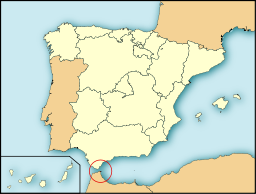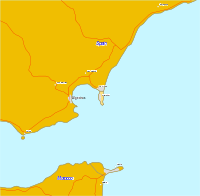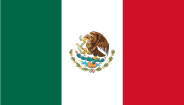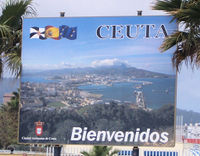Ceuta
| Ceuta | |||
| Ciudad Autónoma de Ceuta | |||
| Municipality | |||
 Ceuta, as seen from the belvedere of Isabel II, near the Moroccan border
|
|||
|
|||
| Official name: Autonomous City of Ceuta | |||
| Name origin: Roman (Latin) name for one of the seven mountains in the Septem Fratres region | |||
| Country | |||
|---|---|---|---|
| Autonomous City | Ceuta | ||
| Center | Almina Pennisula | ||
| - elevation | 10 m (33 ft) | ||
| - coordinates | |||
| Highest point | Monte Hacho | ||
| - location | Monte Hacho | ||
| - elevation | 291 m (955 ft) | ||
| - coordinates | |||
| Lowest point | Sea level | ||
| - location | Atlantic Ocean | ||
| - elevation | 0 m (0 ft) | ||
| Length | 9.41 km (6 mi), W-E | ||
| Width | 5.92 km (4 mi), N-S | ||
| Area | 18.5 km² (7 sq mi) | ||
| Population | 75,276 | ||
| Density | 4,068.97 / km² (10,539 / sq mi) | ||
| Founded | 42 A.D. | ||
| Autonomy Statuate | 14 March 1995 | ||
| Government | Palacio Municipal o Asamblea | ||
| - location | Plaza de África, Ceuta, Ceuta | ||
| - elevation | 10 m (33 ft) | ||
| - coordinates | |||
| Mayor | Juan Jesús Vivas Lara (PP) | ||
| Timezone | Spain (UTC+1) | ||
| - summer (DST) | Spain (UTC0) | ||
| Postal code | 51001 Ceuta | ||
| ISO 3166-2 | ES-CE | ||
| Demonym | Ceutan | ||
| Official languages | Spanish | ||
| Cortes Generales | Parliament | ||
| Congress | 1 deputy (of 350) | ||
| Senate | 2 senators (of 264) | ||
 Location of the Autonomous City of Ceuta
|
|||
| Website: http://www.ceuta.es/ | |||
Ceuta (Spanish pronunciation: [ˈθeu̯ta]) is a 19 square kilometres (7.3 sq mi) Spanish autonomous city located along Mediterranean coast of North Africa across from the Strait of Gibraltar, which separates it from the Iberian peninsula.
Ceuta, along with the Spanish autonomous city of Melilla and a number of Mediterranean islands, are claimed by Morocco.
Contents |
History


c place has made it an important commercial trade and military way-point for many cultures, beginning with the Carthaginians in the 5th century BC, who called the city Abyla. It was not until the Romans took control of the region in A.D. 42 that the port city, then named Septem, assumed an almost exclusive military purpose. It was exchange hands approximately 400 years later, when Vandal tribes ousted the Romans, then fall into the hands of the Visigoths, and finally become an outpost of the Byzantine Empire.
Around 710, as Muslim armies approached the city, its Byzantine governor, Julian (described as King of the Ghomara) changed his allegiance, and exhorted them to invade the Iberian Peninsula. Under the leadership of Berber General Tariq ibn Ziyad, Ceuta was used as a staging ground for an assault on Visigothic Spain. After Julian's death, the Arabs took direct control of the city; this was resented by the indigenous Berber tribes, who destroyed it during the Kharijite rebellion led by Maysara al-Haqir in 740.
It lay in ruins until it was resettled in the 9th century by Mâjakas, chief of the Majkasa Berber tribe, who started the short-lived Banu Isam dynasty. His great-grandson would briefly Allie his tribe with the Idrisids, but their rule would finally end when he abdicated in favor of the Umayyad Caliph of Cordoba, Abd ar-Rahman III, in 931. Ceuta reverted to Hispanic Andalusian rule in 927, along with Melilla, and laterTangier, in 951. Chaos ensued with the fall of the Umayyad caliphate in 1031, but eventually Ceuta and the rest of Muslim Spain, would fall into the hands of successive North African dynasties. Starting in 1084, the Almoravid Berbers ruled the region until 1147, when the Almohads who conquered the land and ruled, apart from Ibn Hud's rebellion of 1232, until the Tunisian Hafsids established their control. The Hafsids' influence in the west rapidly waned, and Ceuta´s inhabitants eventually expelled them in 1249. After this, a period of political instability persisted, under competing interests from the Kingdom of Fez and the Kingdom of Granada. The Kingdom of Fez finally conquered the region in 1387, with assistance from the Crown of Aragon.
In 1415, during the Battle of Ceuta, the city was captured by the Portuguese during the reign of John I of Portugal. The King of Spain seized the Portuguese throne in 1580 and held it for 60 years ( Iberian Union ). During this time Ceuta gained many residents of Spanish origin.[1] Thus Ceuta became the only city of the Portuguese Empire that sided with Spain when Portugal regained its independence in 1640 and war broke out between the two countries.
The formal allegiance of Ceuta to Spain was recognized by the Treaty of Lisbon by which, on January 1, 1668, King Afonso VI of Portugal formally ceded Ceuta to Carlos II of Spain. However, the originally Portuguese flag and coat of arms of Ceuta remained unchanged and the modern-day Ceuta flag features the configuration of the Portuguese shield. The flag's background is also the same as that of the flag of Lisbon.
When Spain recognized the independence of Spanish Morocco in 1956, Ceuta and the other plazas de soberanía remained under Spanish rule as they were considered integral parts of the Spanish state. Culturally, modern Ceuta is considered part of the Spanish region of Andalusia. Indeed, it was attached to the province of Cádiz until 1925 — the Spanish coast being only 20 km away. It is a cosmopolitan city, with a large ethnic Berber Muslim minority as well as Sephardic Jewish and Hindu[2] minorities.
On November 5, 2007, King Juan Carlos I visited the city, sparking great enthusiasm from the local population and protests from the Moroccan government.[3] It was the first time a Spanish head of state had visited Ceuta in 80 years.
Ecclesiastical history
The Catholic Diocese of Ceuta existed from 1417 to 1879. It was a suffragan of the Patriarchate of Lisbon until 1675, with the end of the Iberian Union, when Ceuta chose to remain linked to the king of Spain. Since then it was a suffragan of the archbishopric of Seville.[4] The Diocese of Tanger was suppressed and incorporated to that of Ceuta in 1570.[5]
In 1851, upon the signature of the concordat between the Holy See and Spain, the diocese of Ceuta was agreed to be suppressed, being combined into the diocese of Cádiz y Ceuta[6] (up to then diocese of Cádiz y Algeciras), whose bishop usually was the apostolic administrator of Ceuta. The agreement was not implemented until 1879.
Geography
Ceuta is dominated by a hill called Monte Hacho, on which there is a fort used by the Spanish army. Monte Hacho is one of the possible locations for the southern of the Pillars of Hercules of Greek legend, the other possibility being Jebel Musa.
Climate
| Climate data for Ceuta | |||||||||||||
|---|---|---|---|---|---|---|---|---|---|---|---|---|---|
| Month | Jan | Feb | Mar | Apr | May | Jun | Jul | Aug | Sep | Oct | Nov | Dec | Year |
| Average high °C (°F) | 14 (57) |
15 (59) |
16 (61) |
17 (63) |
19 (66) |
22 (72) |
25 (77) |
25 (77) |
23 (73) |
20 (68) |
17 (63) |
15 (59) |
19 (66) |
| Daily mean °C (°F) | 13 (55) |
13 (55) |
15 (59) |
15 (59) |
17 (63) |
21 (70) |
23 (73) |
23 (73) |
22 (72) |
19 (66) |
16 (61) |
14 (57) |
18 (64) |
| Average low °C (°F) | 12 (54) |
12 (54) |
13 (55) |
13 (55) |
16 (61) |
18 (64) |
21 (70) |
21 (70) |
20 (68) |
17 (63) |
15 (59) |
13 (55) |
16 (61) |
| Avg. precipitation days | 7 | 7 | 4 | 5 | 3 | 1 | 0 | 0 | 1 | 6 | 7 | 8 | 49 |
| Source: Weatherbase[7] | |||||||||||||
Administration

Ceuta is known officially in Spanish as Ciudad Autónoma de Ceuta (English: Autonomous City of Ceuta), with a rank between a standard Spanish city and an autonomous community.
Ceuta is part of the territory of the European Union. The city was a free port before Spain joined the European Union in 1986. Now it has a low-tax system within the European Monetary System. As of 2006, its population was 75,861.
Ceuta does not have an airport. There is, however, a regular helicopter service from Ceuta Heliport linking it to Málaga Airport. All other access to and from Ceuta is by ferry or land.
Ceuta is subdivided into 63 barriadas (English: neighborhoods), such as Barriada de Berizu, Barriada de P. Alfonso, Barriada del Sarchal, and El Hacho.[8][9][10]
Twin towns — sister cities
Ceuta is twinned with:
 Aci Catena, Italy
Aci Catena, Italy Algeciras, Spain
Algeciras, Spain Cadiz, Spain
Cadiz, Spain Guadalajara, Mexico
Guadalajara, Mexico Melilla, Spain
Melilla, Spain Santarém, Portugal
Santarém, Portugal
Political status
Since 1995, Ceuta is, along with Melilla, one of the two autonomous cities of Spain.[11]
The government of Morocco has repeatedly called for Spain to transfer the sovereignty of Ceuta and Melilla, along with uninhabited islets such as the islands of Alhuceima, Velez and the Perejil island, drawing comparisons with Spain's territorial claim to Gibraltar. In both cases, the national governments and local populations of the disputed territories reject these claims by a large majority. The Spanish position states that both Ceuta and Melilla are integral parts of the Spanish state, and have been since the 15th century, centuries prior to Morocco's independence from Spain in 1956, whereas Gibraltar, being a British Overseas Territory, is not and never has been part of the United Kingdom.[12] Morocco denies these claims and maintains that the Spanish presence in Ceuta and the other presidios on its coast is a remnant of the colonial past which should be ended. However, the United Nations list of Non-Self-Governing Territories do not consider those Spanish territories to be colonies, whereas it does declare Gibraltar as a non-decolonized territory.
Economy

The official currency of Ceuta is the euro. It is part of a special low tax zone in Spain.[13] Ceuta is one of two Spanish port cities on the northern shore of Africa, along with Melilla. They are historically military strongholds, free ports, oil ports, and also fishing and smuggling centers.[14] Today the economy of the city depends heavily on its port (now in expansion) and its industrial and retail centres.[15] Ceuta Heliport is now used to connect the city to mainland Spain by air.
Along with Melilla, Ceuta is the main link to and from the plazas de soberanía, especially the Islas Chafarinas, occupied by Spain during the 19th century.
Transport
The city receives high numbers of ferries each day, most from Spain. Occasionally, cruise ships stop by. Most all dock within an easy walk of downtown shops and restaurants.
Ceuta is a tiny city and the best way to travel may be by bicycle or on foot. There are taxis available. There is a bus service with modern and spacious buses running around the city with stops at the border with Morocco.[16]
Churches
- Parroquia De Santa Maria De Los Remedios
- Comunidad Israelita De Ceuta
- Parroquia De San Francisco
- Santa Iglesia Catedral
- Parroquia Santa Maria De Africa — Casa Parroquial
- Vicaria General Del Obispado De Ceuta
- Parroquia Santa Teresa De Jesus De Ceuta
Schools
- Colegio Público José Ortega y Gasset
- Instituto de Educación Secundaria Siete Colinas
- Centro de Educación Infantil y Primaria Andrés Manjón
- Centro de Educación Infantil y Primaria Lope De Vega
- Centro de Educación Infantil Globitos
- Instituto de Educación Secundaria Puertas del Campo
- Colegio Sta. María Micaela
- Instituto de Educación Secundaria Almina
- Centro de Educación Infantil y Primaria Maestro José Acosta
- Colegio Severo Ochoa
- Centro de Educación Infantil y Primaria Santiago Ramón y Cajal
See also
- Benzú
- Ceuta border fence
- Rock of Gibraltar
References
- ↑ Griffin, H (2010). Ceuta Mini Guide. Mirage. ISBN 978-0-9543335-3-9.
- ↑ "Resistir en el monte del Renegado · ELPAÍS.com". Elpais.com. 2009-03-22. http://www.elpais.com/articulo/espana/Resistir/monte/Renegado/elpepuesp/20090322elpepinac_9/Tes. Retrieved 2009-06-17.
- ↑ "Ceuta y Melilla son España, dice Juan Carlos I; Sebta y Melilia son nuestras, responde Mohamed VI". Blogs.periodistadigital.com. 1999-02-22. http://blogs.periodistadigital.com/infordeus.php/2007/11/06/p125486. Retrieved 2009-06-17.
- ↑ David M. Cheney. "''Catholic Hierarchy'' page". Catholic-hierarchy.org. http://www.catholic-hierarchy.org/diocese/dc206.html. Retrieved 2010-08-08.
- ↑ "Catholic Encyclopedia: Tingis". Newadvent.org. 1912-07-01. http://www.newadvent.org/cathen/14736a.htm. Retrieved 2010-08-08.
- ↑ "Catholic Encyclopedia: Cadiz". Newadvent.org. 1908-11-01. http://www.newadvent.org/cathen/03131b.htm. Retrieved 2010-08-08.
- ↑ "Weatherbase: Historical Weather for Ceuta". http://www.weatherbase.com/weather/weatherall.php3?s=2306&refer=&units=metric.
- ↑ "elpueblodeceuta.es". elpueblodeceuta.es. http://www.elpueblodeceuta.es/200708/20070819/200708195101.html. Retrieved 2009-06-17.
- ↑ http://www.planetware.com/i/map/MAR/ceuta-map.jpg
- ↑ "Códigos postales de Ceuta en Ceuta". Codigo-postal.info. http://codigo-postal.info/ceuta/ceuta?page=7. Retrieved 2009-06-17.
- ↑ "Ley Orgánica 1/1995, de 13 de marzo, Estatuto de Autonomía de Ceuta". Noticias.juridicas.com. http://noticias.juridicas.com/base_datos/Admin/lo1-1995.html. Retrieved 2009-06-17.
- ↑ Tremlett, Giles (2003-06-12). "A rocky relationship | World news | guardian.co.uk". London: Guardian. http://www.guardian.co.uk/world/2003/jun/12/worlddispatch.gibraltar. Retrieved 2009-06-17.
- ↑ "Economic Data of Ceuta, de ceutna digital". Ceuta.es. http://www.ceuta.es/servlet/ContentServer?idioma=es_es&mD=true&pagename=CeutaTur%2FInformacionViajero%2FInformacionViajeroDetalle&cid=1113994915129&mC=true&idP=1111055969345&idA=1113994915129. Retrieved 2009-06-17.
- ↑ pp. 6–7, IBRU, Boundary and Territory Briefing. Ceuta and the Spanish Sovereign Territories: Spanish and Moroccan. Books.google.com. http://books.google.com/books?id=xuBgaSzsYVgC&printsec=frontcover&dq=ceuta+economy&source=gbs_summary_r&cad=0#PPA7,M1. Retrieved 2009-06-17.
- ↑ "Economic Data of Ceunta, de ceutna digital". Ceuta.es. http://www.ceuta.es/servlet/ContentServer?idioma=es_es&mD=true&pagename=CeutaTur%2FInformacionViajero%2FInformacionViajeroDetalle&cid=1113994915129&mC=true&idP=1111055969345&idA=1113994915129. Retrieved 2009-06-17.
- ↑ "Ceuta travel guide". Wikitravel. 2010-03-06. http://wikitravel.org/en/Ceuta#Get_around. Retrieved 2010-08-08.
External links
- (Spanish) - Turismo Ceuta
- (Spanish) Information on the history of Ceuta
- (Spanish) Official Ceuta government website
- (Spanish) Official Expoceuta website
- Time Magazine: Al-Qaeda Eyes Spain's 'Lost City'
- Spain's North African enclaves
- Documentary about illegal immigrants trying to reach Ceuta from Morocco
- Satellite image of Ceuta
- Images of Ceuta
- A brief history of Ceuta
 This article incorporates text from a publication now in the public domain: Herbermann, Charles, ed (1913). "Diocese of Cadiz". Catholic Encyclopedia. Robert Appleton Company.
This article incorporates text from a publication now in the public domain: Herbermann, Charles, ed (1913). "Diocese of Cadiz". Catholic Encyclopedia. Robert Appleton Company.
|
|||||||||||||
|
|||||||
|
||||||||||||||||||||||||||||||
|
|||||||||||
|
|||||||||||||||||||||||||||||||||||||

